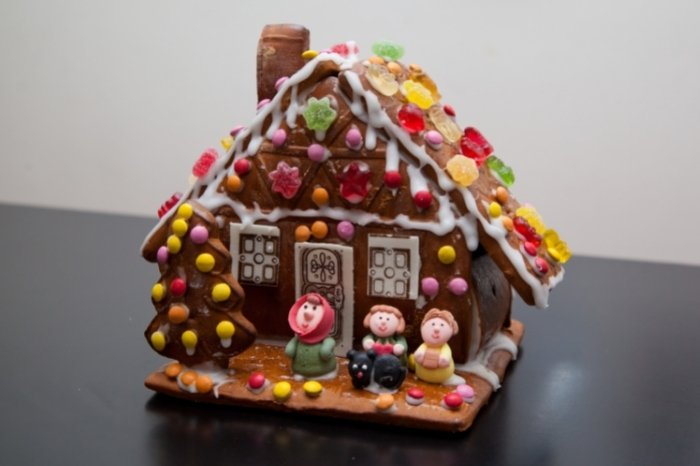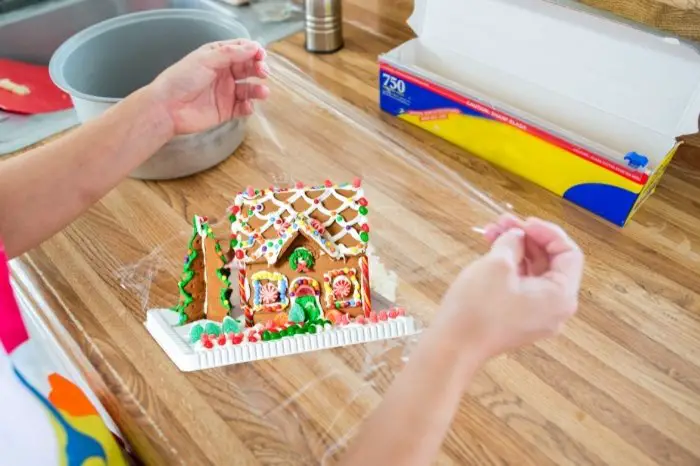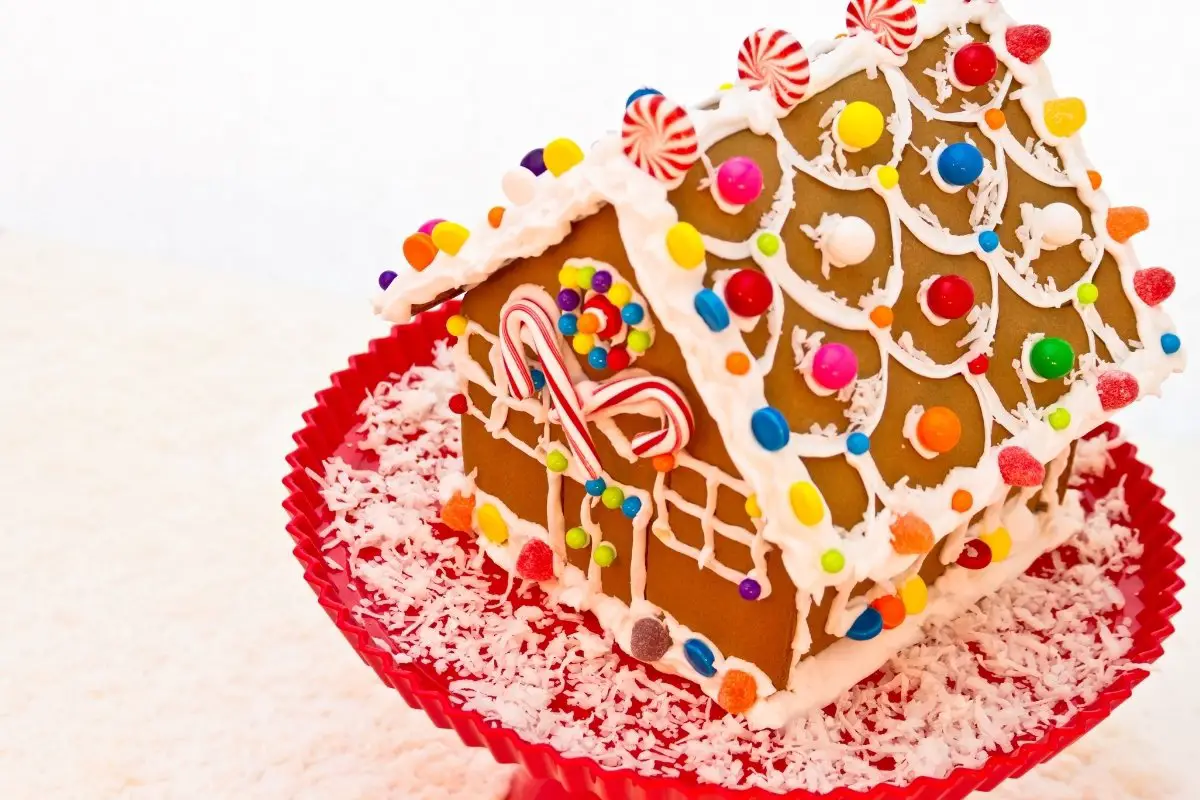Last Updated on February 6, 2022
If you enjoy baking at Christmas time, you will want to know how long do gingerbread houses last. Not only do gingerbread houses taste amazing, but they are also beautiful to display in your home. This Christmas classic makes for a wonderful project to make with your whole family.
When it comes to making a gingerbread house, you can let your imagination run wild. There are so many different designs you can make and decorations you can add. To make it even better, you can enjoy eating your gingerbread house after making it or let it sit out on display for the holiday season.
The Tradition of Gingerbread Houses
Gingerbread houses originated in Germany and rose to popularity in the 1800s. Supposedly, the houses came to fruition after the fairytale of Hansel and Gretel was published in 1812.
Shortly after German bakers began creating gingerbread houses it became a Christmas tradition. The tradition made its way to the United States with Pennsylvanian German immigrants.

Now, gingerbread houses are a popular Christmas tradition all around the world. Every year at Christmas time, people bake and decorate these festive treats. Some are used strictly for display, whereas others are eaten.
Read more about Tips For Decorating Sugar Cookies For Christmas
How Long Does a Gingerbread House Last?
Generally, a gingerbread house can last up to 12 months with proper storage and care. However, if you plan to eat your gingerbread house, they will not last as long as a display.
After a gingerbread house has been made, it can last for about a month before it comes unedible. At this point, the gingerbread and candy decorations will begin to come stale and lose their flavor. You might notice that the gingerbread has become hard and is starting to become discolored.
How Do You Store a Gingerbread House?
Homemade gingerbread dough can last up to one week in the fridge. If you wrap the dough in plastic wrap and aluminum foil or place it in an airtight container, it can last in the freezer for up to a month.
A homemade gingerbread house will only stay fresh for about 2-3 weeks and a storebought one will stay fresh for around a month. Though you can display them longer than that, they may not taste good past that point.

To properly store your gingerbread house for as long as possible, double wrap it in plastic wrap at night. This will help keep dust and bugs away. Be sure to store it in a cool, dry area, so the house will hold up.
In addition, you may place your gingerbread house in a large airtight container. However, if you notice any mold, throw out your gingerbread house. Though it is not recommended to keep it in the fridge, you can freeze it for several months.
How to Preserve a Gingerbread House
If you wish to keep your gingerbread house, you may preserve it. By preserving it, it will no longer be edible, but you can keep displaying it.
To preserve a gingerbread house, spray it with clear lacquer or varnish, which you can find at hardware and craft stores. The lacquer will preserve your house and help it stay together while keeping it looking fresh. However, once you spray it with lacquer or any varnish, it is no longer safe to eat.
Store your preserved house in a plastic bag and then place it in a box. Make sure the box is bug-proof, as you don’t want to attract any pests when you store it.
Fox Run Christmas Village Gingerbread House Cookie Cutter Set, 22 Piece, Stainless Steel
Be certain to store your gingerbread house in a cool, dry area. Heat and humidity are a gingerbread house’s worst enemies. They can cause the house to crumble and fall apart.
Tips and Tricks for Making Your Very Own Gingerbread House
In order for your gingerbread house to last, you must take proper steps when building it. If your gingerbread house begins to fall apart when you make it, it won’t be able to last through the holiday season.
When constructing your gingerbread house, be sure to let it set for at least eight hours before decorating. The frosting holds the house together, so it must be completely dry in order for it to be structurally sound. If the frosting isn’t dry yet, the gingerbread house won’t be sturdy and may fall if you begin to decorate it.
If you do not plan to eat your gingerbread house and are only going to use it for display purposes, you can use a hot glue gun to assemble it. This is even stronger than icing and will allow the house to be sturdy, lessening the chances of it falling down.
Once you have fully decorated your gingerbread house, allow it to sit for a few hours to ensure everything is dry and has set. Once ready, carefully transfer it using a cardboard box to where you would like to display it. Be sure to keep it somewhere that is out of reach of pets and small children, as it can be tempting for them to eat.
Storing Your Beautiful Gingerbread House
Knowing how long do gingerbread houses last will help you out when you are planning to make one. They are a wonderful Christmas tradition, as they are a great activity to make with your family and display for the holiday season.
When properly stored, a gingerbread house has the potential to last up to a year. However, if you plan to eat it, your gingerbread house will only stay fresh for about 2-4 weeks. Be certain every night to tightly cover it up in plastic wrap to keep bugs and dust away.
If desired, you may preserve your gingerbread house as well. To preserve it, spray it with lacquer or varnish spray and make sure no one eats it. Your preserved house can be kept in a plastic bag in a bug-proof box when not displayed.
If you have any questions on how long do gingerbread houses last, please don’t hesitate to ask them down below. Gingerbread houses have a rich history and have become a popular tradition all across the world.
Read more about Do You Eat Gingerbread Houses.

Ever since she was a young girl, Anna has been a lover of desserts. As an adult, she enjoys
baking a variety of desserts from cakes, cookies, brownies, bread, and more from scratch. She
enjoys sharing her passion for baking with others who also have a sweet tooth. From properly
measuring ingredients to making sure they are the correct temperature, Anna knows the
importance small details can make in baking. She wants to share her experience with others in
hopes they can make the most delicious baked goods. When she’s not busy blogging, Anna
enjoys trying new recipes in the kitchen.


